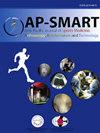The residual laxity of medial collateral ligament after magic point pie crusting MCL released in arthroscopic management of medial meniscus
IF 1.4
Q3 ORTHOPEDICS
Asia-Pacific Journal of Sport Medicine Arthroscopy Rehabilitation and Technology
Pub Date : 2024-09-25
DOI:10.1016/j.asmart.2024.09.001
引用次数: 0
Abstract
Background
In order to do arthroscopic surgery on medial meniscus injuries, there must be enough joint space and good visibility for instrumentation. There is a possibility of iatrogenic cartilage damage if the medial joint space is reduced. Therefore, a medial collateral ligament (MCL) releasing procedure may be necessary for the majority of individuals with medial knee tightness. The MCL residual laxity after pie-crusting release during arthroscopic medial meniscus repair in medial knee tightness were studied in this study.
Methods
Between July 2022 and June 2023, fourteen patients (4 male, 10 female) underwent medial meniscus surgery with pie-crusting release of the superficial MCL. Mean age was 50 ± 10 years (range, 35–63 years). Medial meniscal lesions were meniscus root tear in 10 cases (71.5 %), longitudinal tear in 2 (14.5 %), horizontal tear in 1 (7 %) and radial tear in 1 (7 %). Preoperatively, valgus stress radiographs were obtained. During surgery if arthroscopic exploration revealed medial joint space narrowing after applying valgus force with the knee in 20 degrees of flexion, pie-crusting MCL release was performed. At the 3-month follow-up, valgus stress radiographs were obtained. Residual MCL laxity was assessed by comparing preoperative and 3-month follow-up medial joint space width measurements.
Result
At the 3-month follow-up, no significant increase in the medial joint space width on valgus stress radiograph was observed in comparison to the preoperative. The medial joint space width on valgus stress radiograph was 7.42 ± 1.16 mm preoperatively and 7.47 ± 1.15 mm at 3-month postoperatively (p value = 0.914). All patients had no intraoperative iatrogenic cartilage injury and no saphenous nerve injury after operation.
Conclusions
The magic point pie-crusting MCL release is a reliable and useful procedure to arthroscopic surgery in patients with medial meniscal injury and medial knee tightness. Furthermore, percutaneous pie-crusting MCL release had no effect on residual valgus laxity at the last follow-up.
关节镜治疗内侧半月板时,魔点派结痂 MCL 释放后内侧副韧带的残余松弛度
背景要对内侧半月板损伤进行关节镜手术,必须有足够的关节间隙和良好的器械视野。如果内侧关节间隙缩小,就有可能造成软骨的先天性损伤。因此,对于大多数膝关节内侧紧绷的患者来说,内侧副韧带(MCL)松解术可能是必要的。方法在 2022 年 7 月至 2023 年 6 月期间,14 名患者(4 名男性,10 名女性)接受了内侧半月板手术,并对浅层 MCL 进行了饼状松解。平均年龄为 50 ± 10 岁(35-63 岁)。内侧半月板病变包括半月板根部撕裂10例(71.5%)、纵向撕裂2例(14.5%)、水平撕裂1例(7%)和径向撕裂1例(7%)。术前需要拍摄外翻应力片。手术期间,如果关节镜检查发现膝关节屈曲20度施加外翻力后内侧关节间隙变窄,则进行MCL饼状松解术。在3个月的随访中,进行了外翻应力X光片检查。结果3个月随访时,外翻应力片上的内侧关节间隙宽度与术前相比没有明显增加。术前外翻应力片上的内侧关节间隙宽度为 7.42 ± 1.16 mm,术后 3 个月时为 7.47 ± 1.15 mm(P 值 = 0.914)。结论对于半月板内侧损伤和膝关节内侧紧绷的患者来说,魔术点式MCL松解术是关节镜手术的一种可靠而有效的方法。此外,经皮点皮MCL松解术对最后一次随访时的残余外翻松弛没有影响。
本文章由计算机程序翻译,如有差异,请以英文原文为准。
求助全文
约1分钟内获得全文
求助全文
来源期刊
CiteScore
3.80
自引率
0.00%
发文量
21
审稿时长
98 days
期刊介绍:
The Asia-Pacific Journal of Sports Medicine, Arthroscopy, Rehabilitation and Technology (AP-SMART) is the official peer-reviewed, open access journal of the Asia-Pacific Knee, Arthroscopy and Sports Medicine Society (APKASS) and the Japanese Orthopaedic Society of Knee, Arthroscopy and Sports Medicine (JOSKAS). It is published quarterly, in January, April, July and October, by Elsevier. The mission of AP-SMART is to inspire clinicians, practitioners, scientists and engineers to work towards a common goal to improve quality of life in the international community. The Journal publishes original research, reviews, editorials, perspectives, and letters to the Editor. Multidisciplinary research with collaboration amongst clinicians and scientists from different disciplines will be the trend in the coming decades. AP-SMART provides a platform for the exchange of new clinical and scientific information in the most precise and expeditious way to achieve timely dissemination of information and cross-fertilization of ideas.

 求助内容:
求助内容: 应助结果提醒方式:
应助结果提醒方式:


